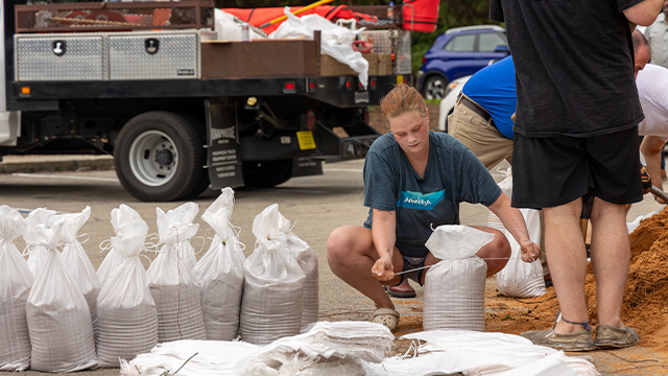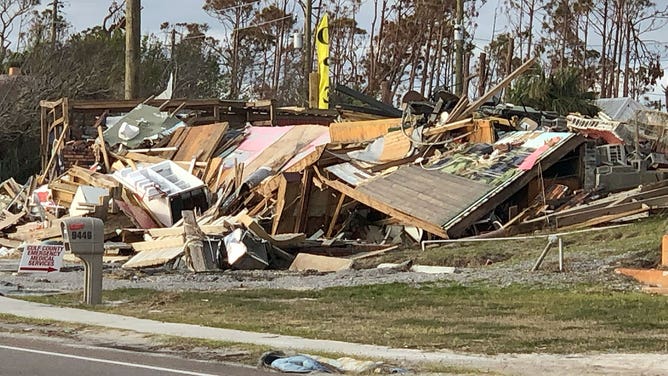Florida under state of emergency for major threat from Hurricane Helene
Hurricane Helene remains a Category 1 cyclone but is knocking on the door of becoming a Category 2 during the next few hours.
TALLAHASSEE, Fla. – Residents and leaders on Florida’s Gulf Coast and the Panhandle aren’t wasting time getting ready for the looming tropical threat, as Hurricane Warnings are now in effect for Hurricane Helene as it approaches the state on Thursday.
A state of emergency has expanded to cover all but six counties in Florida.

Kyley Weems bags sand in preparation for possible flooding on September 25, 2024 in Tallahassee, Florida. Forecasts predict Tropical Storm Helene will strengthen to a hurricane, making landfall along the Florida Gulf Coast on Thursday.
(Sean Rayford / Getty Images)
Helene continues to gather strength as it heads toward the warm waters of the Gulf of Mexico. The National Hurricane Center is warning millions of people across the Gulf Coast region to prepare for potential impacts, which could be felt as soon as Wednesday.

(FOX Weather)
Forecast to become a major hurricane, the system will bring life-threatening storm surge, damaging winds, heavy rainfall and dangerous rip currents to Florida’s west coast. Current forecasts show a potential Category 3 hurricane at landfall, according to the National Hurricane Center (NHC).
Hurricane Warnings have been issued for Tallahassee and Cedar Key as Helene intensifies.
Lee Mayfield, Director of Response for Hagerty Consulting, spoke about this hurricane season, focusing on Potential Hurricane Helene, flood preparation and emergency management team response.
NHC Deputy Director Jamie Rhome said regardless of where the storm makes landfall, storm surge and coastal flooding will be a major concern along Florida’s Nature Coast.
“So the bottom line here for the Florida west coast, it doesn’t matter where it tracks,” Rhome said. “We’re going to have significant coastal flooding along just about everywhere on the Florida west coast.”

This image shows waves crashing on shore in Grand Cayman as Tropical Storm Helene lashes the region.
(@Kelsey_RaeSmith/X)
Florida state of emergency expands
Florida Gov. Ron DeSantis issued a state of emergency for 61 counties on Tuesday to help agencies prepare for the storm. The governor also requested a pre-landfall emergency declaration from FEMA.
On Tuesday, several counties issued mandatory evacuations for their residents and additional evacuation orders are coming in for other areas along Florida’s Big Bend region. A full list can be found here.

This image shows Florida residents filling sandbags ahead of likely Hurricane Helene in the coming days.
(@LeonCounty/ X)
In Leon County, home to Florida’s capital Tallahassee, sandbags are being offered to residents in anticipation of torrential rain and flooding – one of many sandbag distribution sites open throughout the Florida Panhandle. The Tallahassee city government is also making other preparations for the incoming storm.
Steven Hartsook, Emergency Disaster Services Director for The Salvation Army, Florida Division, spoke to FOX Weather about how his team is preparing to help residents as Tropical Storrn Helene makes its way toward Florida. Sept. 24, 2024.
Helene is a large storm, and its impacts will be felt across much of Florida on approach and after landfall.
“Big hurricanes are big problems no matter where you put them, because it’s going to have a huge wind swath,” Rhome said. “It’s going to basically go over the Florida Peninsula, possibly the densely populated I-4 corridor. That’s a high potential for power outages .”
Florida’s Interstate 4 corridor includes big cities such as Tampa and Orlando, home to all the major theme parks, including Disney World.
Florida State University is set to close its Tallahassee campus on Wednesday for the remainder of the week due to the storm.
Florida Panhandle has been hit hard before
The Florida Panhandle is no stranger to devastating hurricanes and tropical storms.
In 2018, Hurricane Michael became the strongest hurricane to make landfall in Florida since Hurricane Andrew in 1992. Areas of the Panhandle from Panama City Beach to Mexico Beach continue to rebuild after the storm’s 140-mph winds and storm surge devastated beach towns.
Rhome said, similar to Michael, this incoming storm will have a fast forward speed when it moves over Florida.
“It’s going to be booking it when it moves over Florida,” the NHC deputy director said. “What that allows a storm to do is spread those strong winds farther inland than might normally expect … Hurricane Michael is a great case of where the inland damaging winds spread well inland. So that’s going to be our next concern, is making sure those inland locations understand the extreme wind risk that could come with this one.”
Monday marked 49 years since Hurricane Eloise made landfall as a major hurricane east of Fort Walton Beach and Destin. The 1975 storm was the first major hurricane to hit the Panhandle region in 40 years, according to the National Weather Service.
Source link










